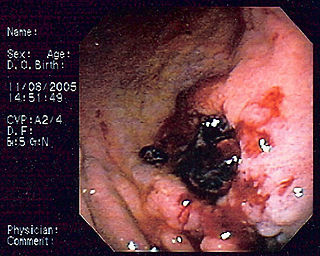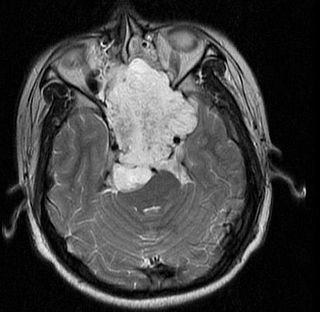Related Research Articles

Radiation therapy or radiotherapy is a treatment using ionizing radiation, generally provided as part of cancer therapy to either kill or control the growth of malignant cells. It is normally delivered by a linear particle accelerator. Radiation therapy may be curative in a number of types of cancer if they are localized to one area of the body, and have not spread to other parts. It may also be used as part of adjuvant therapy, to prevent tumor recurrence after surgery to remove a primary malignant tumor. Radiation therapy is synergistic with chemotherapy, and has been used before, during, and after chemotherapy in susceptible cancers. The subspecialty of oncology concerned with radiotherapy is called radiation oncology. A physician who practices in this subspecialty is a radiation oncologist.

Brachytherapy is a form of radiation therapy where a sealed radiation source is placed inside or next to the area requiring treatment. The word "brachytherapy" comes from the Greek word βραχύς, brachys, meaning "short-distance" or "short". Brachytherapy is commonly used as an effective treatment for cervical, prostate, breast, esophageal and skin cancer and can also be used to treat tumours in many other body sites. Treatment results have demonstrated that the cancer-cure rates of brachytherapy are either comparable to surgery and external beam radiotherapy (EBRT) or are improved when used in combination with these techniques. Brachytherapy can be used alone or in combination with other therapies such as surgery, EBRT and chemotherapy.

Glioblastoma, previously known as glioblastoma multiforme (GBM), is the most aggressive and most common type of cancer that originates in the brain, and has a very poor prognosis for survival. Initial signs and symptoms of glioblastoma are nonspecific. They may include headaches, personality changes, nausea, and symptoms similar to those of a stroke. Symptoms often worsen rapidly and may progress to unconsciousness.

In medicine, proton therapy, or proton radiotherapy, is a type of particle therapy that uses a beam of protons to irradiate diseased tissue, most often to treat cancer. The chief advantage of proton therapy over other types of external beam radiotherapy is that the dose of protons is deposited over a narrow range of depth; hence in minimal entry, exit, or scattered radiation dose to healthy nearby tissues.
Total body irradiation (TBI) is a form of radiotherapy used primarily as part of the preparative regimen for haematopoietic stem cell transplantation. As the name implies, TBI involves irradiation of the entire body, though in modern practice the lungs are often partially shielded to lower the risk of radiation-induced lung injury. Total body irradiation in the setting of bone marrow transplantation serves to destroy or suppress the recipient's immune system, preventing immunologic rejection of transplanted donor bone marrow or blood stem cells. Additionally, high doses of total body irradiation can eradicate residual cancer cells in the transplant recipient, increasing the likelihood that the transplant will be successful.

MALT lymphoma is a form of lymphoma involving the mucosa-associated lymphoid tissue (MALT), frequently of the stomach, but virtually any mucosal site can be affected. It is a cancer originating from B cells in the marginal zone of the MALT.

Chordoma is a rare slow-growing neoplasm thought to arise from cellular remnants of the notochord. The evidence for this is the location of the tumors, the similar immunohistochemical staining patterns, and the demonstration that notochordal cells are preferentially left behind in the clivus and sacrococcygeal regions when the remainder of the notochord regresses during fetal life.

In radiotherapy, radiation treatment planning (RTP) is the process in which a team consisting of radiation oncologists, radiation therapist, medical physicists and medical dosimetrists plan the appropriate external beam radiotherapy or internal brachytherapy treatment technique for a patient with cancer.

Tomotherapy is a type of radiation therapy treatment machine. In tomotherapy a thin radiation beam is modulated as it rotates around the patient, while they are moved through the bore of the machine. The name comes from the use of a strip-shaped beam, so that only one “slice” of the target is exposed at any one time by the radiation. The external appearance of the system and movement of the radiation source and patient can be considered analogous to a CT scanner, which uses lower doses of radiation for imaging. Like a conventional machine used for X-ray external beam radiotherapy, a linear accelerator generates the radiation beam, but the external appearance of the machine, the patient positioning, and treatment delivery is different. Conventional linacs do not work on a slice-by-slice basis but typically have a large area beam which can also be resized and modulated.
Intraoperative electron radiation therapy is the application of electron radiation directly to the residual tumor or tumor bed during cancer surgery. Electron beams are useful for intraoperative radiation treatment because, depending on the electron energy, the dose falls off rapidly behind the target site, therefore sparing underlying healthy tissue.

Human papillomavirus-positive oropharyngeal cancer, is a cancer of the throat caused by the human papillomavirus type 16 virus (HPV16). In the past, cancer of the oropharynx (throat) was associated with the use of alcohol or tobacco or both, but the majority of cases are now associated with the HPV virus, acquired by having oral contact with the genitals of a person who has a genital HPV infection. Risk factors include having a large number of sexual partners, a history of oral-genital sex or anal–oral sex, having a female partner with a history of either an abnormal Pap smear or cervical dysplasia, having chronic periodontitis, and, among men, younger age at first intercourse and a history of genital warts. HPV-positive OPC is considered a separate disease from HPV-negative oropharyngeal cancer.

Targeted intra-operative radiotherapy, also known as targeted IORT, is a technique of giving radiotherapy to the tissues surrounding a cancer after its surgical removal, a form of intraoperative radiation therapy. The technique was designed in 1998 at the University College London.
Embryonal rhabdomyosarcoma (EMRS) is a rare histological form of cancer in the connective tissue wherein the mesenchymally-derived cells (rhabdomyoblasts) resemble the primitive developing skeletal muscle of the embryo. It is the most common soft tissue sarcoma occurring in children. Embryonal rhabdomyosarcoma is also known as PAX-fusion negative or fusion-negative rhabdomyosarcoma, as tumors of this subtype are unified by their lack of a PAX3-FOXO1 fusion oncogene. Fusion status refers to the presence or absence of a fusion gene, which is a gene formed from joining two different genes together through DNA rearrangements. These types of tumors are classified as embryonal rhabdomyosarcoma "because of their remarkable resemblance to developing embryonic and fetal skeletal muscle."
Wolfgang Axel Tomé is a physicist working in medicine as a researcher, inventor, and educator. He is noted for his contributions to the use of photogrammetry in high precision radiation therapy; his work on risk adaptive radiation therapy which is based on the risk level for recurrence in tumor sub-volumes using biological objective functions; and the development of hippocampal avoidant cranial radiation therapy techniques to alleviate hippocampal-dependent neurocognitive impairment following cranial irradiation.
Financial toxicity describes the negative impact medical expenses can have on patients in terms of their health-related quality of life. It leads to negative mental and physical effects as well as, in some cases, bankruptcy, loss of job or income, or even homelessness.
Sandro Porceddu is a head and neck radiation oncologist at Brisbane's Princess Alexandra Hospital and a Professor with the University of Queensland. He was president of the Clinical Oncologic Society of Australia (COSA) and chair of the Trials Scientific Committee of the Trans Tasman Radiation Oncology Group (TROG).

Dr. Daniel Przybysz is a Brazilian Radiation-Oncologist. His practice is mainly focused on lung cancer treatment and high technology approaches toward better patient care

Nancy Y. Lee is a Taiwanese-born American physician and the vice-chair of the Department of Radiation Oncology in Memorial Sloan Kettering's Department of Medicine.
Diffusing Alpha-emitters Radiation Therapy or DaRT is an alpha-particle-based radiation therapy for the treatment of solid tumors.
Catharine West is a British cancer researcher who specialised in radiation biology. She is an emeritus professor at the University of Manchester, where she worked from 2002 until 2022.
References
- ↑ Barnett GC, Elliott RM, Alsner J, Andreassen CN, Abdelhay O, Burnet NG, Chang-Claude J, Coles CE, Gutiérrez-Enríquez S, Fuentes-Raspall MJ, Alonso-Muñoz MC, Kerns S, Raabe A, Symonds RP, Seibold P, Talbot CJ, Wenz F, Wilkinson J, Yarnold J, Dunning AM, Rosenstein BS, West CM, Bentzen SM (2012). "Individual patient data meta-analysis shows no association between the SNP rs1800469 in TGFB and late radiotherapy toxicity". Radiother Oncol. 105 (3): 289–95. doi:10.1016/j.radonc.2012.10.017. PMC 3593101 . PMID 23199655.
- ↑ Barnett GC, Coles CE, Elliott RM, Baynes C, Luccarini C, Conroy D, Wilkinson JS, Tyrer J, Misra V, Platte R, Gulliford SL, Sydes MR, Hall E, Bentzen SM, Dearnaley DP, Burnet NG, Pharoah PD, Dunning AM, West CM (2012). "Independent validation of genes and polymorphisms reported to be associated with radiation toxicity: a prospective analysis study". Lancet Oncol. 13 (1): 65–77. doi: 10.1016/S1470-2045(11)70302-3 . PMID 22169268.
- ↑ Talbot CJ, Tanteles GA, Barnett GC, Burnet NG, Chang-Claude J, Coles CE, Davidson S, Dunning AM, Mills J, Murray RJ, Popanda O, Seibold P, West CM, Yarnold JR, Symonds RP (2012). "A replicated association between polymorphisms near TNFα and risk for adverse reactions to radiotherapy". Br J Cancer. 107 (4): 748–53. doi:10.1038/bjc.2012.290. PMC 3419947 . PMID 22767148.
- ↑ Das, AK; Bell MH; Nirodi CS; Story MD; Minna JD (2010). "Radiogenomics predicting tumor responses to radiotherapy in lung cancer". Sem Radiat Oncol. 20 (3): 149–55. doi:10.1016/j.semradonc.2010.01.002. PMC 2917342 . PMID 20685577.
- ↑ Yard, Brian D.; Adams, Drew J.; Chie, Eui Kyu; Tamayo, Pablo; Battaglia, Jessica S.; Gopal, Priyanka; Rogacki, Kevin; Pearson, Bradley E.; Phillips, James (2016-04-25). "A genetic basis for the variation in the vulnerability of cancer to DNA damage". Nature Communications. 7: 11428. Bibcode:2016NatCo...711428Y. doi:10.1038/ncomms11428. ISSN 2041-1723. PMC 4848553 . PMID 27109210.
- ↑ Andreassen, CN; Alsner J; Overgaard J (2002). "Does variability in normal tissue reactions after radiotherapy have a genetic basis--where and how to look for it?". Radiother Oncol. 64 (2): 131–40. doi:10.1016/s0167-8140(02)00154-8. PMID 12242122.
- ↑ West CM, McKay MJ, Hölscher T, Baumann M, Stratford IJ, Bristow RG, Iwakawa M, Imai T, Zingde SM, Anscher MS, Bourhis J, Begg AC, Haustermans K, Bentzen SM, Hendry JH (2005). "Molecular markers predicting radiotherapy response: report and recommendations from an International Atomic Energy Agency technical meeting". Int J Radiat Oncol Biol Phys. 62 (5): 1264–73. doi:10.1016/j.ijrobp.2005.05.001. PMID 16029781.
- ↑ Bentzen, SM (2006). "Preventing or reducing late side effects of radiation therapy: radiobiology meets molecular pathology". Nat Rev Cancer. 6 (9): 702–13. doi:10.1038/nrc1950. PMID 16929324. S2CID 1190053.
- ↑ West C, Rosenstein BS, Alsner J, Azria D, Barnett G, Begg A, Bentzen S, Burnet N, Chang-Claude J, Chuang E, Coles C, De Ruyck K, De Ruysscher D, Dunning A, Elliott R, Fachal L, Hall J, Haustermans K, Herskind C, Hoelscher T, Imai T, Iwakawa M, Jones D, Kulich C, EQUAL-ESTRO, Langendijk JH, O'Neils P, Ozsahin M, Parliament M, Polanski A, Rosenstein B, Seminara D, Symonds P, Talbot C, Thierens H, Vega A, West C, Yarnold J (2010). "Establishment of a Radiogenomics Consortium". International Journal of Radiation Oncology, Biology, Physics. 76 (5): 1295–1296. doi:10.1016/j.ijrobp.2009.12.017. PMID 20338472.
- ↑ West, C; Rosenstein BS (2010). "Establishment of a radiogenomics consortium". Radiother Oncol. 94 (1): 117–8. doi:10.1016/j.radonc.2009.12.007. PMID 20074824.
- ↑ "National Cancer Institute of Health - Epidemiology and Genomics Research Program".
- ↑ Radiomics